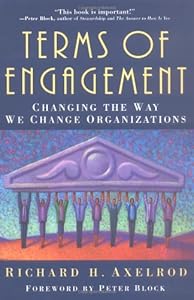Not long ago, I reviewed the latest edition of Terms of Engagement, the great book on organizational change by Dick Axelrod that helps you engage the people you need to make the change process work. Dick is a speaker, author, consultant, and educator who, along with his wife Emily, co-founded The Axelrod Group, which has pioneered the use of employee involvement to affect organizational change since 1981. Happily, Dick also agreed to respond to e-mail interview questions for us, discussing organizational change and social media, among other topics.
Me: How did you end up doing what you do? It seems like a rather unique calling.
DA: I’m an accidental consultant. My interest in organizational change began early when I worked for my father who manufactured model airplanes. From there, I went on to learn first-hand the power of engaging people in organizational change as a repair service manager for the Bell System where I managed repair service for the Southwest Side of Chicago. My unit piloted one of the Bell System’s, first organizational development change processes. I went on to be an internal organization development consultant within the Bell System and then at General Foods. At General Foods I was involved in their pioneering efforts with self-teams. In 1981 I left General Foods to form the Axelrod Group.
MM: For those who are not familiar with your book, Terms of Engagement, can you summarize the big idea?
DA: This book is about people, engaged people. It’s about people at all levels who come together to make decisions that are in interest of the organization and the people who work there. It is about a set of principles and practices that when followed create the engaged organization.
MM. Since the first edition of Terms of Engagement, have you seen more acceptance of your ideas on change management?
DA: Yes. When Terms of Engagement was first published engagement was not a word that people used a lot. Now when people talk about change management they talk about how to engage people in the change process. In the beginning people thought the only reason to engage people was to reduce resistance. Recent findings in Neuroscience and Complexity theory indicate that went you engage people , innovation, collaboration, and creativity are sparked.
MM: What do you see as the biggest change that has happened in change management in recent years?
DA: The biggest change I’ve seen is the recognition that it is important to engage all stakeholders early and often during the change process. There is some debate about when and how to engage people, but there is no debate about the need to engage people. McKinsey & Company, in a global study of successful organizational transformations (2010), identified co-creation, collaboration, and employee engagement as key success indicators.
MM: What effect has the Internet and other digital technologies had on change management?
DA: They have opened the process up. It makes it easier for people to learn what is going on, to input into the process, and be in the know. It also leaders to communicate to everyone in the organization at the same time allows people to communicate with their leadership. One only has to look at recent events in Egypt to understand the power of Internet and digital technologies when it comes to change.
MM: Does the advent of social media change the hierarchies in organizations that contribute to old-fashioned top-down change management?
DA: I don’t believe social media change the hierarchies per se. But they do have an impact. Even simple email makes it easy for people to communicate across hierarchies and functions. Organizations have used social media to open the organization up through forums and discussions. Conversations once confined to the people you knew or to people who were located close by, are now being held globally.
MM: As companies try to get employees to participate in social media, what lessons should they learn as to how to go about that organizational change?
DA: I think we are still learning about to effectively use social media when it comes to organizational change. I think most important thing is the access to honest, transparent information. Social media needs to become a trusted information resource. In that way people can differentiate between chatter and the facts.
MM: Given the ability of social media to cross the boundaries of a company from employees to their customers, do you think that your principle of being more inclusive in the change process should extend to a company’s customers?
DA: Absolutely, when you bring customers into the conversation it makes all the difference in the world. There are always misgivings about involving customers, for example the fear of airing your dirty laundry in public. Our experience is that when you involve customers in the process two things happen. You get new and different information and your customers become more invested in what you are trying to do. My bias is to involve customers directly so you can have face to face conversations and learn from each other. I think the use of social media behind an organizations firewall would make some sense. However, while having customers in the conversation adds tremendous value, that value can be reduced in a totally open forum. Some of these discussions require some privacy. So I think we need to figure out how to use the benefits of social media while providing the privacy that thoughtful discussions require.
MM: Looking into your crystal ball, what should change management consultants be looking for in the future?
DA: We have to get good at change management that spans the globe. This means being able to work across time zones, cultures, and language. I believe social media, the internet, and technologies not yet invented will help us but they are supporting mechanisms. We need to learn to be able to make these human connections that span beliefs, history, culture and language. Once these connections are made then change process can take off with a life of its own.
MM: Thanks, Dick, for taking the time to share your thoughts with our readers.





